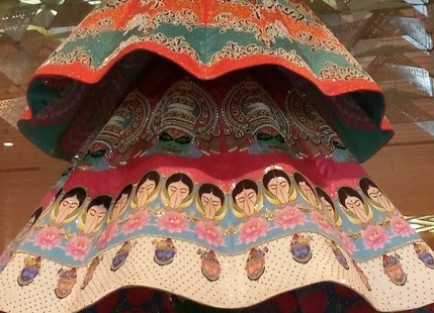BAGGAGE HALL AREA
This area reinvigorates India’s ancient pre-eminence in the arts of textiles and costumes with exotic props celebrating a rare collection of traditional containers. Mumbai international airport is the first of its kind to present a display of the most beautiful hand-crafted trunks, as an introductory guide to the treasures that one can carry home. On exiting the aircraft, at the threshold of the city while awaiting their branded luggage - appearing on rivers turning around islands with nondescript signage - freshly arrived travelers from near and far, witness a celebration of India’s first great export…textiles, that made the city of Mumbai.
Having set an important point of reference with the permanent display, the Museum, in order to stay current and relevant, will be continuously maintained, augmented, re-interpreted and described for all possible audiences with diverse storylines and live audio-visual documentation. For Jaya He, this means that extra attention and care is given to evolve the organisation of an autonomous system within the Corporate structure. This will empower a creative follow through of the Artwork program for a Museum Collection as separate from regular operative procedures.
THE WEDDING DANCE
MANISH ARORA
Manish Arora, has carved a special place in the world of fashion for his unique signature of graphic configurations seamlessly incorporating urban motifs with traditional idioms, has collaborated with Rajeev Sethi to produce this Wedding DaRead More
TIGER, TIGER BURNING BRIGHT
ZANDRA RHODES WITH RAJEEV SETHI
Banners leap out from magical Himalayan trunks evoking stylized representations of the sacred tiger in its glorious avatar as a composite flying form roaring itself into existence. The traditional containers suggest the hilly topography of Read More
SILENT MINERATES AND WHISPERING WINDS
BAARAAN IJLAL & SHABANA AZMI (MIJWAN WELFARE SOCIETY)
KaifiAzmi was a legendary poet of 20th century India and hailed from Mijwan in Uttar Pradesh and it was his vision to see the women of his village empowered. Hi daughter, the actress ShabanaAzmi created a successful project where the women Read More
THE CHINTZ OF INDIA
RITU KUMAR
Chintz are plain woven cotton fabrics that are printed in beautiful range of colours and motifs and widely exported to Europe as far back as the 15th century. These were extremely popular fabrics as they were far more appealing than the draRead More







